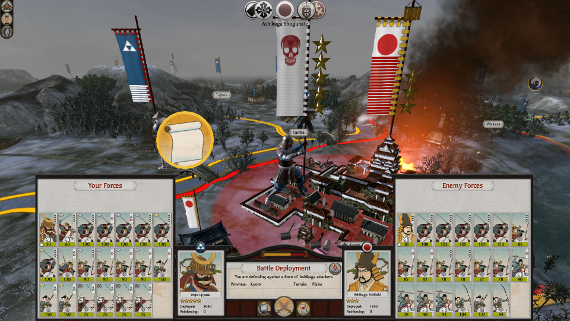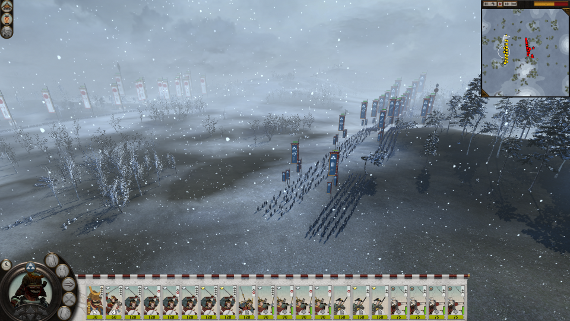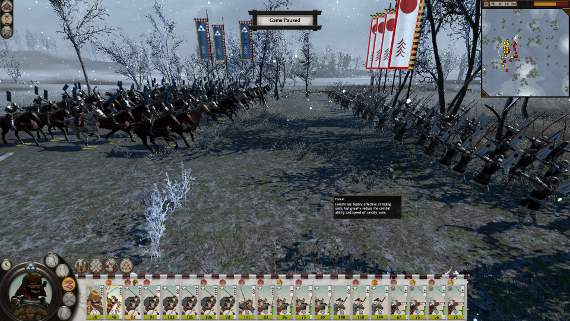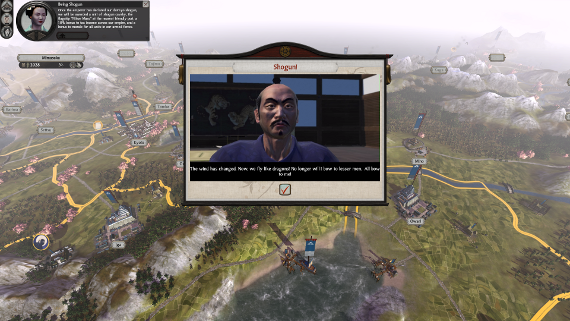Rather than launch a direct assault on Kyoto, we elect to be patient and besiege it instead as the Ashikaga Shogunate still has a large garrison force in the city. It will take more than a year to starve the defenders out and our besieging army will need to survive the travails of winter. But at the same time, the siege itself will whittle down the defenders’ numbers, so we judge it worthwhile. Our Daimyo leads our besieging force while a small secondary army stands by in the vicinity to provide reinforcements if required. Of course, our Daimyo’s sons continue the war against the other clans and we eventually extinguish the Oda while the siege on Kyoto is being maintained.
Fortunately for us, the Ashikaga defenders sally forth to meet us on the field of battle in the depths of winter, foolishly abandoning the elaborate fortifications of the city. The Ashikaga army chooses to attack us in the middle of a snowstorm, which limits the effectiveness or archers. But since both sides have about the same number of archers, it is actually an even trade. While they have many more cavalry, we have numerical superiority overall with many more katana samurai and spearmen. In this battle, we also field our bow warrior monks for the first time.
As the defender, we deploy in our usual formation with archers in front and given skirmishing orders. The best archers are assigned to the center positions along the line. Since we have more katana samurai than yari ashigaru in this battle, the samurai form the main line behind the archers. The spearmen are assigned to the two flanks behind the archers to catch the enemy cavalry as they attempt to flank. Our Daimyo is positioned in the center just behind the katana samurai. Finally, our sole unit of katana cavalry is placed on the left flank, farther out away from the main army. We have found that it is sometimes possible to tempt the enemy to send some units to go after this lone unit of cavalry and thus put them out of position.
The battle goes largely as we predicted with the enemy advancing and taking damage from our massed archers. Just as our archers maneuver to retreat from the approaching infantry, our katana samurai rush through to charge at the enemy. Two units of enemy cavalry try to get behind our lines and are neatly entangled and quickly destroyed by our spearmen. Two other cavalry unit choose to charge into our katana samurai however, and we take high losses at these positions until samurai at other positions rout the enemies they were engaged with and we move them in to provide assistance.
Since the enemy chose not to hold back any infantry to defend their archers, our sole katana cavalry unit are free to run riot amongst them. Overall, the battle is a resounding victory and we use both our cavalry and our Daimyo’s bodyguard unit to run down the fleeing enemies. We do note that the bow warrior monks, although very accurate, seem very fragile and we unexpectedly lose quite a few of them when some are accidentally caught in melee. With te Ashikaga army destroyed, we march into Kyoto virtually unopposed. One year later, during which time we also destroy the Hattori, our Daimyo is finally named Shogun in 1575, thirty years after we began our grand campaign.
End Notes:
- The Hojo special advantages turned out not to matter very much after all. Cheaper castles are useful, but waiting for enemies to attack my castle isn’t proactive enough. Also, I’ve found that I don’t like siege engines. I’d much rather use that unit slot on an archer or something, and attaching siege engines to an army slows its campaign map movement way down.
- I wanted to Christianize the Hojo but I was offered the Nanban Trading Quarter very late in the game. By that time, I already had more than 10 provinces and converting them all to Christianity seemed like too much of a pain. Also, I’d held off on building Buddhist temples for a long time, but after waiting for a long time, I decided to build them after all to get monks. They’re very useful for increasing army movement range and demoralizing enemy armies. Christianizing the Hojo once you have a fair number of temples and monasteries already built feels like even more of a waste.
- One aspect of the game design I didn’t like were the trading nodes because of their first come, first served nature. In this game, I almost completely ignored them because I never had much of a navy, and still did okay in terms of income. That was nice.
- Creating vassals after the realm divide hit would have allowed me to trade with them and that would probably have been a big income boost. But I got lazy about managing diplomacy after a while and simply took all provinces for myself.
- I think one of the AI’s biggest weaknesses is not knowing how to use agents effectively. It doesn’t really know how to coordinate an advancing army with agents to weaken the enemy. This gives the human player a tremendous advantage, especially since the human player can make a determined effort to level up agents with low risk missions.




Leave a Reply